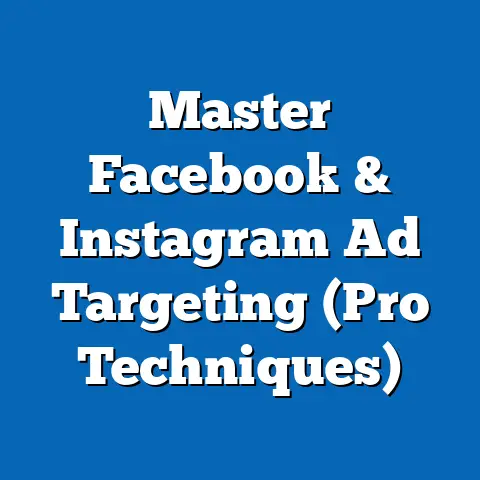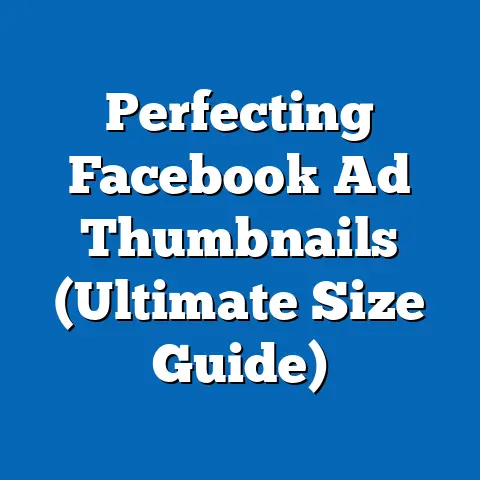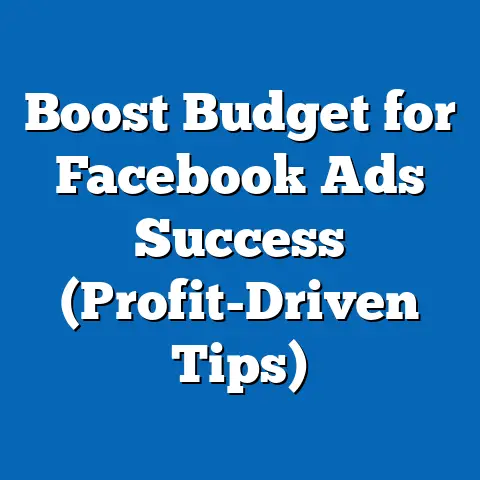Maximize Facebook Retargeting Ads ROI (Cost-Effective Tips)
I often hear marketers say, “Retargeting? That’s for the big guys with deep pockets.” This couldn’t be further from the truth! I’ve seen firsthand how small and medium-sized enterprises (SMEs), even those with modest marketing budgets, can achieve incredible returns on investment (ROI) with Facebook retargeting ads. It’s about being smart, strategic, and understanding how to leverage the platform’s power. Forget the misconception – let’s dive into how you can make retargeting work for your business, regardless of size.
Understanding Facebook Retargeting
Facebook retargeting ads are the secret weapon in any savvy marketer’s arsenal. Unlike regular Facebook ads, which target users based on demographics, interests, or behaviors, retargeting focuses on people who have already interacted with your business in some way. Think of it like this: someone walks into your store, browses a few items, but leaves without buying anything. Retargeting is like politely reminding them about those items they were interested in, offering a compelling reason to come back and complete the purchase.
The magic behind retargeting lies in two key components: the Facebook Pixel and custom audiences.
- Facebook Pixel: This is a small snippet of code that you place on your website. It acts like a silent observer, tracking visitor behavior, such as page views, products added to cart, or even time spent on specific pages.
- Custom Audiences: Once the Pixel is in place, you can create custom audiences based on the data it collects. For example, you can create an audience of people who visited your product page but didn’t add anything to their cart, or an audience of those who added items to their cart but didn’t complete the checkout process.
Retargeting plays a crucial role in the customer journey. Most customers don’t buy on their first interaction with a brand. They need to be nurtured, reminded, and convinced that your product or service is the right choice for them. Retargeting allows you to stay top-of-mind and guide them through the sales funnel, ultimately leading to a conversion. I’ve seen so many businesses increase their sales exponentially just by implementing retargeting strategies!
Takeaway: Facebook retargeting is about reaching people who already know you, increasing the likelihood of conversion. The Facebook Pixel and custom audiences are your tools for making this happen.
The Cost-Effectiveness of Retargeting Ads
The beauty of retargeting is its inherent cost-effectiveness. You’re not throwing money at a broad audience hoping someone will bite. Instead, you’re focusing your efforts on people who have already expressed interest in your brand. This targeted approach translates to higher conversion rates and lower acquisition costs.
Let’s compare retargeting ads to traditional advertising methods. Think about a billboard. You’re paying for impressions, but you have no idea how many people who see it are actually interested in what you’re selling. With retargeting, you’re only paying to show ads to people who have already visited your website, watched a video, or engaged with your content.
Statistics consistently show that retargeting ads have significantly higher conversion rates than first-time ads. According to various studies, retargeting ads can have a click-through rate (CTR) that is 10 times higher than regular display ads. Moreover, visitors who are retargeted are 70% more likely to convert on your website. That’s a huge difference!
I remember working with a small online boutique that sold handmade jewelry. They were struggling to compete with larger brands and had a limited advertising budget. We implemented a retargeting strategy that focused on cart abandoners. Within a month, they saw a 30% increase in sales, and their ROI on advertising spend doubled. This just goes to show that even small businesses can reap significant rewards from retargeting.
Takeaway: Retargeting is more cost-effective than traditional advertising because it focuses on a warm audience, leading to higher conversion rates and a better ROI.
Cost-Effective Tips for Maximizing ROI
Now, let’s get into the nitty-gritty. How can you make the most of your retargeting budget and maximize your ROI? Here are five key tips:
Tip 1: Segmentation of Audiences
Don’t treat all your retargeting audience the same. Segmentation is crucial for delivering relevant and personalized ads. Think about it: someone who simply browsed your homepage is different from someone who added items to their cart but didn’t check out.
Here are some audience segments you can create based on user behavior:
- Page Viewers: People who visited specific product or service pages.
- Time on Site: Users who spent a significant amount of time on your website, indicating a higher level of interest.
- Cart Abandoners: Those who added items to their cart but didn’t complete the purchase.
- Video Viewers: People who watched a certain percentage of your videos.
- Engaged Users: Individuals who liked, commented on, or shared your Facebook posts.
For each segment, create highly targeted ads that address their specific needs and concerns. For example, for cart abandoners, you could offer a discount or free shipping to incentivize them to complete their purchase. For product viewers, you could showcase customer reviews or highlight the benefits of the product they were interested in.
Example: Let’s say you sell running shoes. You could create a retargeting campaign specifically for people who viewed your “Marathon Pro” running shoe page. Your ad copy could say, “Still thinking about the Marathon Pro? Get 10% off your purchase today with code RUN10!” This personalized approach is far more effective than a generic ad promoting all your running shoes.
Takeaway: Segment your retargeting audiences based on behavior and tailor your ad copy and visuals to resonate with each segment.
Tip 2: Creative and Compelling Ad Copy
Your ad copy and visuals are the first things people see, so make them count! Your ads need to be eye-catching, engaging, and relevant to the audience you’re targeting.
Here are some tips for crafting compelling ad copy and visuals:
- Use Strong Headlines: Grab attention with headlines that are clear, concise, and benefit-driven.
- Highlight Benefits, Not Just Features: Explain how your product or service will solve the customer’s problem or improve their life.
- Use High-Quality Images and Videos: Visuals are crucial for capturing attention and conveying your message effectively.
- Include a Clear Call to Action (CTA): Tell people exactly what you want them to do, such as “Shop Now,” “Learn More,” or “Get a Free Quote.”
- A/B Test Different Creatives: Experiment with different ad copy, visuals, and CTAs to see what resonates best with your audience.
A/B testing is your best friend when it comes to optimizing your ad creatives. Try different variations of your ads and track their performance. Facebook Ads Manager makes it easy to set up A/B tests and see which ads are generating the best results.
Example: Let’s say you’re running a retargeting campaign for a fitness app. You could A/B test two different headlines:
- Headline A: “Get Fit with Our Fitness App”
- Headline B: “Reach Your Fitness Goals in 30 Days”
By tracking the click-through rates and conversion rates for each headline, you can determine which one is more effective at driving results.
Takeaway: Invest time in crafting compelling ad copy and visuals that resonate with your target audience. A/B test different creatives to optimize for engagement and conversions.
Tip 3: Frequency Capping
Ad fatigue is a real problem. If people see your ads too many times, they’ll start to ignore them or even become annoyed. This is where frequency capping comes in.
Frequency capping allows you to limit the number of times a user sees your ad within a specific time period. This prevents ad fatigue and ensures that your ads remain fresh and engaging.
So, what’s the optimal frequency setting? It depends on your target audience, your product or service, and your advertising goals. However, a good starting point is to limit ad frequency to 2-3 times per week.
Monitor your engagement metrics closely to see how your audience is responding to your ads. If you notice a decline in click-through rates or an increase in negative feedback, it may be a sign that you need to reduce your ad frequency.
Takeaway: Use frequency capping to prevent ad fatigue and ensure that your ads remain engaging. Monitor your engagement metrics and adjust your frequency settings accordingly.
Tip 4: Leveraging Dynamic Ads
Dynamic ads are a game-changer for e-commerce businesses. They allow you to automatically show relevant products to users based on their previous interactions with your website.
Let’s say someone visits your website and views a specific product. With dynamic ads, you can automatically show them that product in a retargeting ad, along with other related products they might be interested in.
To use dynamic ads, you need to upload a product catalog to Facebook. This catalog contains information about all your products, including images, descriptions, prices, and availability.
Facebook then uses this information to create personalized ads that are tailored to each user’s individual interests. This level of personalization can significantly improve your conversion rates and ROI.
Example: A customer browses a blue sweater on your website. With dynamic ads, they might see an ad featuring that same blue sweater, along with other similar sweaters in different colors or styles.
Takeaway: Dynamic ads are a powerful tool for e-commerce businesses that want to show relevant products to users based on their previous interactions.
Tip 5: Retargeting Window Optimization
The retargeting window is the period of time during which you show ads to users who have interacted with your business. Choosing the right retargeting window is crucial for reaching users who are most likely to convert.
If your retargeting window is too short, you might miss out on potential customers who need more time to make a decision. If it’s too long, you might be wasting money showing ads to people who are no longer interested.
So, how do you determine the optimal retargeting window? It depends on your product or service and your sales cycle. For example, if you’re selling a high-priced item, like a car, you might want to use a longer retargeting window, as people typically take more time to research and make a purchase decision. If you’re selling a low-priced item, like a t-shirt, you might want to use a shorter retargeting window, as people are more likely to make an impulse purchase.
Analyze your user behavior data to determine the optimal time frame for your retargeting efforts. Look at how long it typically takes for users to convert after interacting with your business.
Takeaway: Define the right retargeting window to reach users who are most likely to convert. Analyze user behavior data to determine the optimal time frame for your retargeting efforts.
Measuring Success and Adjusting Strategies
You’ve implemented your retargeting campaigns, but how do you know if they’re working? It’s crucial to track your key performance indicators (KPIs) and make adjustments based on data-driven insights.
Here are some KPIs you should be tracking:
- Click-Through Rate (CTR): The percentage of people who click on your ad.
- Conversion Rate: The percentage of people who complete a desired action, such as making a purchase.
- Cost Per Acquisition (CPA): The cost of acquiring a new customer.
- Return on Ad Spend (ROAS): The revenue generated for every dollar spent on advertising.
Facebook Ads Manager provides a wealth of data on your ad performance. You can track these KPIs and see how your campaigns are performing over time. You can also use Google Analytics to track website traffic and conversions that are driven by your retargeting ads.
Continuous monitoring is key. Don’t just set up your campaigns and forget about them. Regularly check your KPIs and make adjustments as needed. If you see that your CTR is low, try experimenting with different ad copy or visuals. If you see that your CPA is high, try refining your targeting or adjusting your bidding strategy.
Takeaway: Track your KPIs, analyze your data, and make adjustments to your strategies to maximize your ROI.
Conclusion
Facebook retargeting ads are not just for the big players. They’re a powerful tool that businesses of all sizes can use to increase sales, improve ROI, and achieve their marketing goals. By segmenting your audiences, crafting compelling ad copy, using frequency capping, leveraging dynamic ads, and optimizing your retargeting window, you can create cost-effective campaigns that drive results.
Don’t be afraid to experiment and test different strategies to see what works best for your business. With a little bit of effort and a data-driven approach, you can unlock the full potential of Facebook retargeting and take your marketing to the next level.
The impact of well-executed retargeting campaigns on overall business success can be transformative. I’ve seen businesses double, even triple, their revenue by simply implementing the strategies I’ve outlined here. So, what are you waiting for? Start retargeting today and watch your business grow!




